As Digital Sales Grow, Shopping Centers Face a Seismic Threat
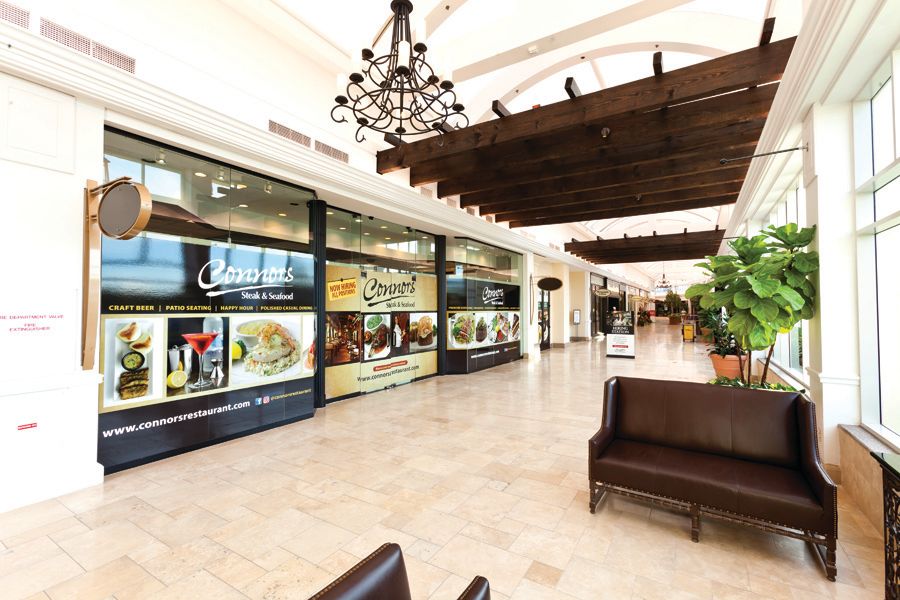
Connors Steak & Seafood, expected to open this fall, is one of several new restaurants reshaping Westfield Siesta Key.
When Sarasota’s Southgate Mall lost two of its three anchor stores—Dillard’s and Saks Fifth Avenue—it faced a familiar crossroads in today’s retail landscape: reinvent itself or perish.
Reinvention seems to be winning. Today, the center has a new name—Westfield Siesta Key—and more the feel of a community gathering place than a traditional mall. Macy’s is the lone department store remaining. But new additions, some open and others coming soon, include Lucky’s Market, LA Fitness, L’Core Spa, CineBistro and a slew of restaurants new to the area, including Metro Diner, Connors Steak & Seafood, Bravo Coastal Bar & Kitchen and Naples Flatbread and Wine Bar. Construction crews have been busy, adding 22,000 square feet of new space, the biggest expansion since the mall was enclosed in 1988.
“I know there were people who wondered whether we would be able to survive,” says Christa Kremer, Westfield’s South Florida marketing director. “But we took our time because we wanted to do it right and give the community what it wanted. Today, it’s hard not to get excited about where we’re heading.”
Kremer still refers to Westfield Siesta Key as a mall, but not in the traditional sense where customers go simply to shop. Instead, she says, patrons may come in the morning for a workout or spa treatments, grab a meal or a craft beer at Lucky’s and pick up a blouse to wear that evening at one of the boutiques. At night, customers might come for dinner and a movie, and browse shops in between. “We’re offering a lot of experiences in a great location,” Kremer says.
TooJay’s Original Gourmet Deli, which has been a fixture at the mall for nearly 20 years, has been so pleased with the changes that it extended its lease for 10 years and plans to upgrade the restaurant late this summer with a remodeling project costing “several hundred thousand dollars,” says TooJay’s CEO Chris Artinian.
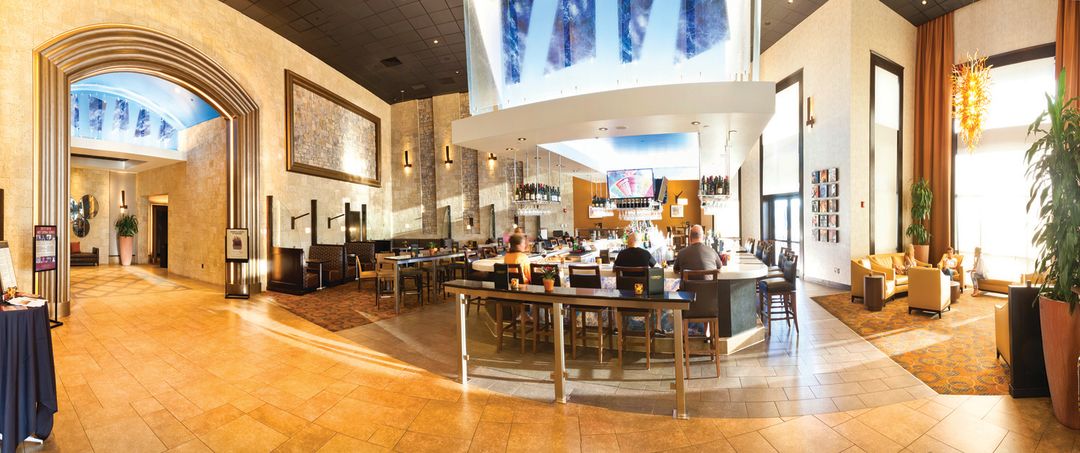
CineBistro Siesta Key has become a popular attraction at Westfield Siesta Key, offering gourmet dining, a full bar and luxurious seating for movies.
Image: Gene Pollux
“They answered the call,” Artinian says of mall operator, Westfield. “We did have a decision to make on whether to stay. But when we saw the direction they were going, we wanted to be part of the rebirth. It’s become more of a lifestyle center and we’re really excited to be part of a vibrant restaurant scene that is coming together there.”
Yet challenges remain. While business is expanding on the mall’s periphery, Westfield Siesta Key’s map shows around a dozen empty storefronts inside the mall. The fate of the mall’s lone department store also remains tenuous: Macy’s has closed 68 stores across the nation already this year and analysts say more closings are likely.
The picture is even more clouded at two other local malls. DeSoto Square in Bradenton, which has been sold three times in the past five years, has more empty storefronts than occupied ones. Its movie theater has not reopened since closing last spring amid reports of a rat infestation.
DeSoto Square’s new owner, New York-based Meyer Lebovitz, who paid $25 million for it in February, has pledged to spend $7 million in upgrades. In Sarasota, Westfield Sarasota Square has lost two anchors, Macy’s and Sears, as well as several smaller retailers such as Men’s Wearhouse and Hobby Marketplace.
Even the $315 million jewel in the crown of local retail, the Mall at University Town Center, has lost more than 10 stores since its opening three years ago, though its anchors Dillard’s, Saks Fifth Avenue and Macy’s remain in place, along with popular smaller stores such as Apple.
Strip malls and shopping centers also have been hit hard by closings of chains such as hhgregg, Gymboree, Sports Authority, RadioShack, Kmart and Payless. Through June 23, analysts Fung Global Retail and Tech reported that 5,321 chain stores had closed nationally, a 213 percent increase over the first six months of 2016. The number was surpassed only once, in the first six months of 2008 during the start of the Great Recession. That the closings are happening today at a time of rising wages and near full employment raises questions about how quickly the pace will accelerate when the next recession hits.
From 2011 to 2016, the number of people employed in the retail industry increased by about 25 percent and wages increased by 14 percent in the Sarasota-Bradenton-North Port region, according to data collected by CareerSource Suncoast.
One area that continues to boom is the University Parkway corridor. Benderson Development has built a half dozen shopping centers along University Parkway that surround its centerpiece mall. From The Fresh Market to the Whole Foods Market under construction, the strip centers are near capacity, despite the challenging landscape for retail these days. Restaurants seem to have the greatest turnover in the corridor. But more is coming. Benderson Development has proposed office, apartments and retail development along I-75, hoping that the growing neighboring Lakewood Ranch development will continue to support this network of stores and restaurants.
“Our region’s population growth has increased the demand for retail, and you can see that just by driving down University Parkway on any given day,” says Jen Zak, a spokeswoman for CareerSource Suncoast. “New stores are constantly popping up and ‘now hiring’ signs are in most storefronts. With the saturation of retail outlets in our region, we expect the wages to increase as retail businesses try to retain their employees who have many options in the job market.”
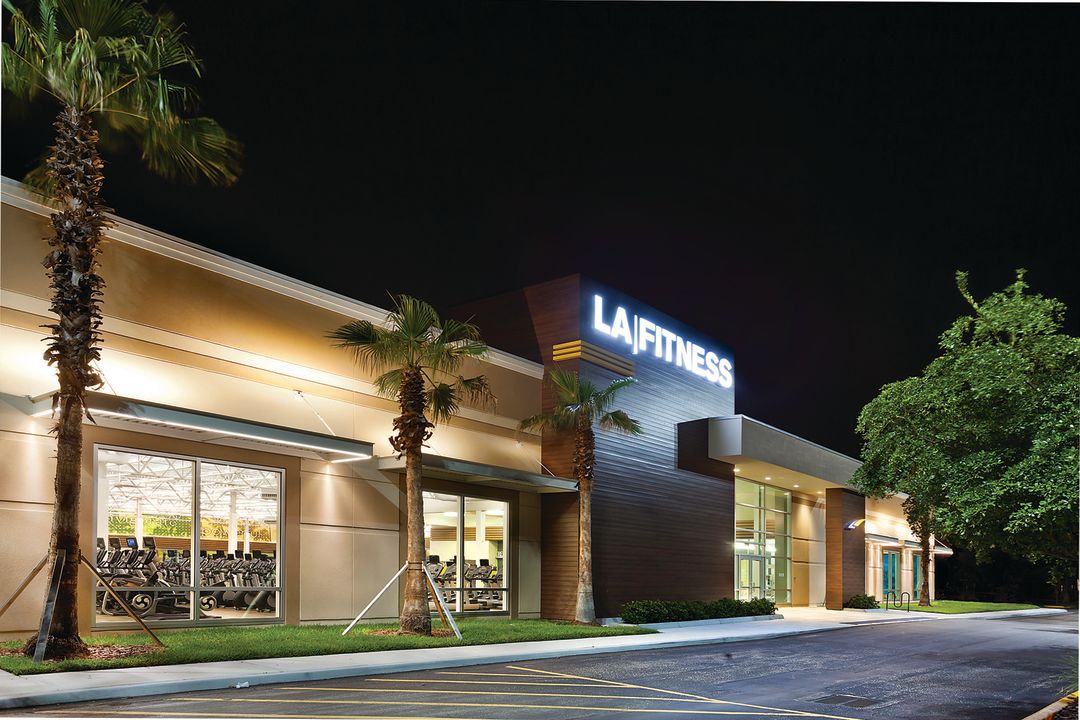
LA Fitness brings a new dimension to Westfield Siesta Key.
Image: Gene Pollux
The recent trend may not be predictive of what’s to come. The combination of store closings and automation is expected to eventually curtail employement. But Zak had no predictions on how jobs will be affected in the rest of the year forecast, given the recent closures in the region. Nationally, the U.S. economy has lost more than 71,000 retail jobs since the beginning of the year, according to the U.S. Bureau of Labor Statistics.
Beyond the macro-economic picture, there are many million reasons that trend is likely to intensify: 80 million, to be precise, which is the number of Americans who now subscribe to Amazon Prime, paying $99 annually to get expedited shipping, movies and other services from the online behemoth. In the past three years, the percentage of retail sales shifting online to Amazon and other digital retailers has grown from 5 percent to 14 percent. That leads one prominent retail analyst to say that even though Sarasota-Bradenton’s population is growing, housing construction is booming and tourism remains strong, the number of stores here is likely to decline in coming years.
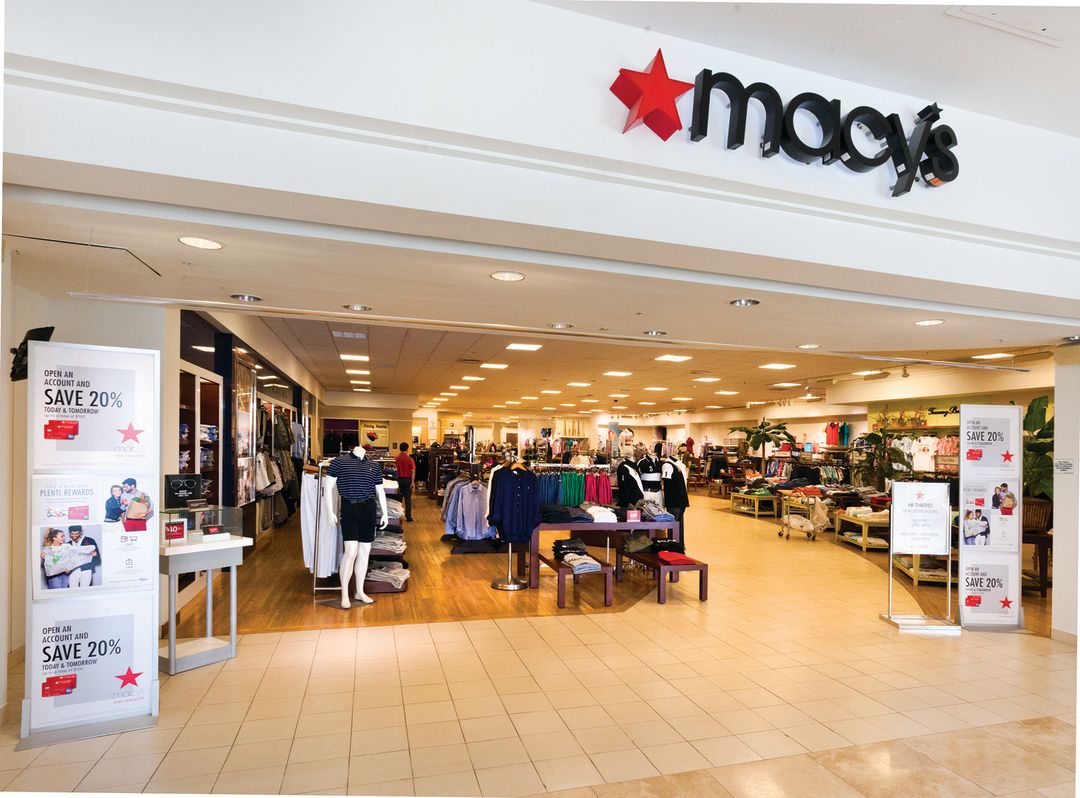
Macy’s is the Westfield Siesta Key's only department store.
Image: Gene Pollux
“There’s no doubt about it, Sarasota is over-retailed now,” says Jeff Green, an analyst from Phoenix who has studied the Sarasota retail market. “It’s not unique to Sarasota. It’s part of a seismic shift that’s taking place for brick-and-mortar retailers. And even though the Sarasota-Bradenton area is experiencing significant population growth, I expect the number of stores to decline as the internet continues to grow and baby boomers age and cut back their spending.
“It’s like watching needles stab the pincushion right now,” Green adds. “It’s not a quick death, it’s more like a disease.”
Will malls get mauled?
The financial firm Credit Suisse reports that 20 percent to 25 percent of the nation’s 1,100 shopping malls will close within the next five years. That’s up to 275 malls. The study also predicts a sharp rise in e-commerce sales.
“Malls are still great real estate and have the potential to become something completely different,” Green says, adding that the changes at Westfield Siesta Key show the possibilities when mall owners look beyond the traditional four department store anchor formula. “The key is finding the highest and best use for these properties.”
Beyond adding restaurants, fitness centers and groceries, some mall owners have added offices and even residential units. Green says the potential to live or work in an area close to shopping, recreation, dining and entertainment is attractive for millennials in particular. DeSoto Square Mall is an example of a struggling traditional mall that could prosper by taking a new direction. Local commercial brokers say a medical center, school or even apartments could work there.
“We’ve been through this before. We’re looking at retail today and seeing a lot of vacancies, but also a lot of rehabs of existing centers and main streets. There are great, busy shopping corridors out there that we’ve never had before,” says Faith Hope Consolo, chairman of The Retail Group with Douglas Elliman Real Estate in New York City.
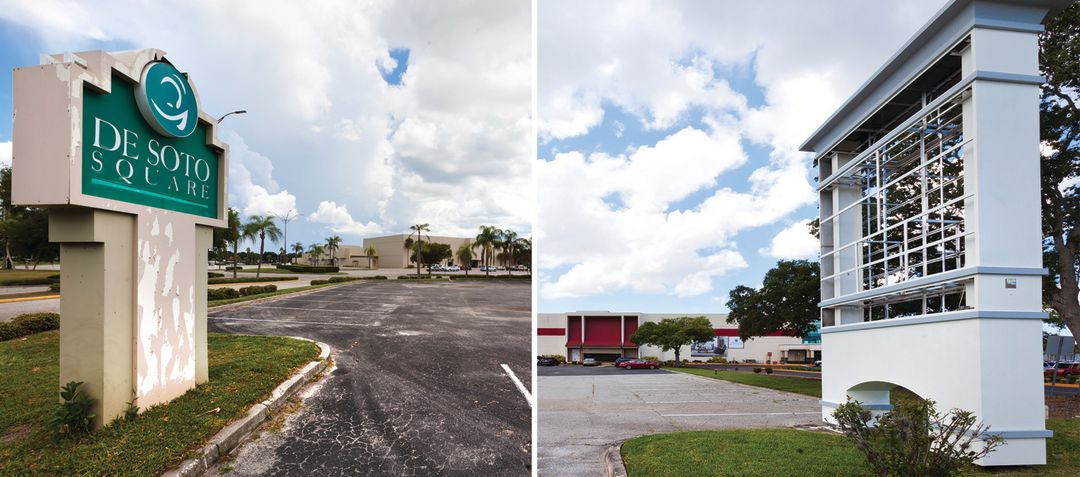
DeSoto Square Mall has been sold three times in the past five years and has a slew of empty storefronts. Analysts say housing, a medical facility or other nontraditional businesses may be the best hope for such aging shopping centers.
Image: Gene Pollux
One center that seems to have hit the bull’s-eye in the new retail landscape is Pelican Plaza off U.S. 41 in south Sarasota. Last spring, while Macy’s was advertising its store closing at Westfield Sarasota Square across Tamiami Trail, the parking lot at Pelican Plaza was packed with customers at Sprouts Farmer’s Market. In 15 years, Sprouts has grown from one store in Chandler, Arizona, to more than 270 nationally. It is part of the healthy, specialty grocery niche that includes recent local additions Trader Joe’s, Earth Fare and Lucky’s and the continued growth of Detwiler’s Farm Market. Green expects the growth to continue because consumers are looking for more healthful options and are willing to shop at different stores for staples and specialty items such as organic vegetables and humanely raised meats. Amazon’s interest in Whole Foods Market, which it acquired earlier this summer, further shows the demand and interest in the health foods concept. The trend, Green says, will hurt traditional full-service groceries, like Florida’s staple, Publix.
“The 40,000-square-foot supermarket with 40,000 products on the shelves is a dinosaur. It’s going extinct. Consumers don’t want that anymore,” adds Phil Lempert, editor of SupermarketGuru.com.
Sprouts is not Benderson’s only success story at Pelican Plaza. Another thriving business is Ulta, the beauty and makeup chain with stores in malls and strip centers, that continues to post positive double-digit sales growth quarter after quarter and skyrocketing shares. Despite investing heavily in its e-commerce operations, Ulta officials say that online business is only incremental compared to its in-store business. Analysts credit Ulta’s success to its nimbleness. The brand is known to partner with major beauty labels and market to millennials. The third major store in Pelican Plaza is Total Wine and More, which has grown to 162 stores nationally since starting in Delaware in 1991. A typical store offers 8,000 different wines, 2,5oo beers and 3,000 spirits, the company says.
One thing Sprout’s, Total Wine and Ulta have in common is seeking interaction with their customers beyond selling products. At Sprouts, monthly classes include topics like baking organic cookies. Total Wine offers classes about wine from different regions and others devoted to trendy liquors such as bourbon. In addition to selling beauty products, Ulta has full-salon treatments focusing on makeup, hair and skin. “People want value and they want experiences,” Green says. “Stores that can deliver those things can be successful.”
Winners & Losers in Retail
Winners:
1. TJ Maxx—This value-oriented chain store is expanding when many other apparel stores are shrinking. The focus on brand names for value prices has pushed TJ Maxx and its similar competitors (think Marshalls) ahead of relic department store chains. TJ Maxx is nimble because it can mix up its assortment of product more easily than a department store. And the prices are low, similar to the fast fashion trend seen in malls from new players like H&M and Forever 21.
2. Ulta—Another nimble player is Ulta, which knows how to use its ecommerce business to support its in-store business. The beauty chain has seen positive double-digit sales growth quarter after quarter and skyrocketing shares. Its in-store business far outweighs its online business.
3. Walmart—The Walmart chain is investing heavily in new ways to reach customers, both online as it competes against Amazon on price and convenience, and in stores where it butts up against everyone from Publix to Target. Customers can pay by app in some stores now. The chain is expanding its grocery curbside pickup program.
Losers:
1. Sears—The longstanding department store chain has reported declining same-store sales for years. More closures come every quarter, including the recent shuttering of its store at Sarasota Square Mall. Sears sold off some of its household brands, like Craftsman Tools, in an effort to save money, but ultimately it pushed more customers away. There’s no resurrecting the flailing chain at this point.
2. Sports Authority—The chain closed all of its 450-plus stores across the U.S. after it went bankrupt and couldn’t secure a buyer earlier this year. Sports Authority failed to be innovative to reach new customers as competitors came into the market, like Dick’s Sporting Goods, and boutique specialty fitness chains, from lululemon to Athletica, emerged.
3. The Limited—Once a classic staple in any American mall, women’s fashion retailer The Limited filed for bankruptcy earlier this year and shuttered all stores. The Limited failed to reinvent to keep up with new trends from newer brands that captured the attention of women shoppers.



